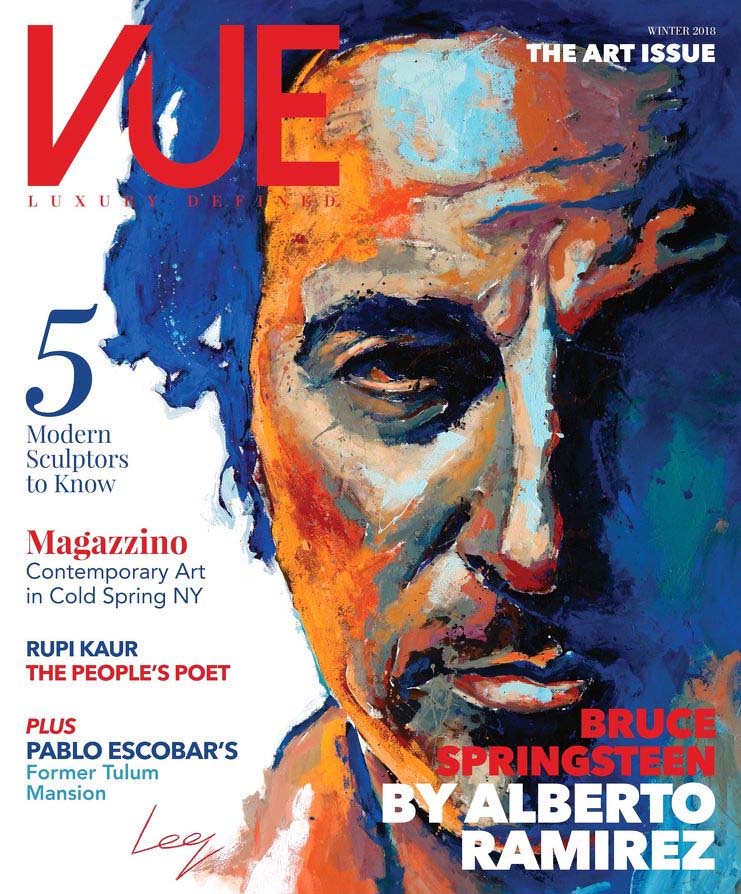Interview Vue Magazine – New York

Pop Culture Portrait — Interview with Alberto Ramirez
For as long as Alberto Ramirez could hold a pencil in his hand, he’s been drawing. The Madrid-born artist began painting in elementary school and simply never looked back. For a large part of his career, Ramirez has focused his efforts on portrait painting. Fascinated by the human face and its ability to tell the most intricate stories with even the smallest expression, he defines his work as “decoding a silent language that needs to be heard.” Ramirez believes that choosing a subject for his paintings is perhaps the most vital part of the process. And what faces can tell a greater story than the mugs of music icons like Bruce Springsteen and Prince? Many of these pop culture-inspired pieces were also born of Ramirez’s project “LEG” which, through a chain of fortuitous events, was a collaborative effort with artist and childhood friend David Partida—a man he’d reunited with in Spain in the early 2000s. Today, Ramirez resides in Berlin where he continues to make his mark with his modern portraits, each one meant to immortalize the character and vigor of their respective stars.
How did the Bruce Springsteen piece come about? What do you want people to feel when they see work like this?
I always try to paint the people I find interesting. In the case of Bruce Springsteen I have a very deep sense of respect and admiration for both his music and him as a person. He has a strong character and transcends a very positive energy. He is the kind of artist that will always be a point of reference for inspiration today as well as for the coming generations. Through his portrait I wanted to externalize his determination. The base of the painting has blue and orange tones. The two of them combined are perceived even more intense, more clear given that they are complementary.
I think that in every artistic piece, may it be a painting, a film or a song, many elements affect its final result. Some you can control and others are alien to you. That is why an artist can create pieces that come out round, complete, at a very high level, and in turn the artist himself can do a mediocre job. In the portrait of Springsteen I think that there were a series of factors that make it a special picture. To externalize through the painting an internal feeling and to make it physical, to translate it into a canvas is not easy. I would like it when people stand in front of Bruce Springsteen’s painting to perceive that energy.
When did you first start your portrait work? What is it about pop culture icons that inspires you?
I have always painted portraits. At first I painted my friends, cartoons or oil portraits. In 2005 I painted a portrait of the Gioconda in a large format, 2 meters by 130 centimeters. In that moment I realized that a large scale face with a firm and dynamic stroke could work quite well. By working the canvas on a large scale, I was able to focus on the painting as if it were an abstraction.
My generation grew up being very influenced by the pop culture of the ‘80s. I love the ability of a character to become a universal social reference. More than the character in question I am interested in the communication process. As a face we can attribute universal values. When we see an image of James Dean we associate it with the rebellion of the individual against the system. With a portrait of Gandhi or Che, we automatically think of revolution.
What I find most compelling about your portrait work is how every painting seems to tell a story. How do you approach your portrait work? What’s your process like?
I am mainly interested in people and their behavior. The face is a window to penetrate their concerns, their fears, their desires. I am fascinated by the ability of a face to convey so much complexity simply with a small gestural change. For me it is not about reproducing an image, but about understanding what is happening in front of me. Interpreting a form, observing how light affects it and transforms it, decoding a silent language that needs to be heard. I try to listen to what some eyes tell me and express it with a vigorous and fluid stroke, a directional line that generates movement.
The process of making a portrait begins by locating the most characteristic features of the face that define a person. Generally the gaze is the feature that defines us most, but it depends on the person. The shape of the lips, for example, can be an essential part that takes us into their personality. Once I analyze his most determining physiological features I look for a photograph that captures his personality well. The search for the image to make the portrait of is one of the most important steps.